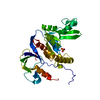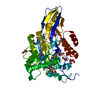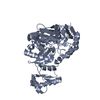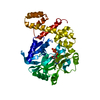+ Open data
Open data
- Basic information
Basic information
| Entry | Database: PDB / ID: 1kjw | ||||||
|---|---|---|---|---|---|---|---|
| Title | SH3-Guanylate Kinase Module from PSD-95 | ||||||
 Components Components | POSTSYNAPTIC DENSITY PROTEIN 95 | ||||||
 Keywords Keywords | NEUROPEPTIDE / PROTEIN-PROTEIN INTERACTION / SCAFFOLD | ||||||
| Function / homology |  Function and homology information Function and homology informationRHO GTPases activate CIT / positive regulation of AMPA glutamate receptor clustering / neuronal ion channel clustering / P2Y1 nucleotide receptor binding / beta-1 adrenergic receptor binding / Neurexins and neuroligins / neuroligin family protein binding / regulation of grooming behavior / structural constituent of postsynaptic density / synaptic vesicle maturation ...RHO GTPases activate CIT / positive regulation of AMPA glutamate receptor clustering / neuronal ion channel clustering / P2Y1 nucleotide receptor binding / beta-1 adrenergic receptor binding / Neurexins and neuroligins / neuroligin family protein binding / regulation of grooming behavior / structural constituent of postsynaptic density / synaptic vesicle maturation / positive regulation of neuron projection arborization / receptor localization to synapse / vocalization behavior / neuron spine / cerebellar mossy fiber / AMPA glutamate receptor clustering / protein localization to synapse / positive regulation of dendrite morphogenesis / proximal dendrite / Trafficking of AMPA receptors / dendritic branch / LGI-ADAM interactions / Activation of Ca-permeable Kainate Receptor / dendritic spine morphogenesis / negative regulation of receptor internalization / frizzled binding / neuron projection terminus / acetylcholine receptor binding / juxtaparanode region of axon / regulation of NMDA receptor activity / dendritic spine organization / cellular response to potassium ion / RAF/MAP kinase cascade / positive regulation of synapse assembly / beta-2 adrenergic receptor binding / NMDA selective glutamate receptor signaling pathway / Synaptic adhesion-like molecules / neuromuscular process controlling balance / neurotransmitter receptor localization to postsynaptic specialization membrane / cortical cytoskeleton / locomotory exploration behavior / AMPA glutamate receptor complex / excitatory synapse / social behavior / regulation of neuronal synaptic plasticity / kinesin binding / glutamate receptor binding / Unblocking of NMDA receptors, glutamate binding and activation / positive regulation of excitatory postsynaptic potential / positive regulation of synaptic transmission / D1 dopamine receptor binding / regulation of postsynaptic membrane neurotransmitter receptor levels / ionotropic glutamate receptor binding / dendrite cytoplasm / synaptic membrane / cell periphery / PDZ domain binding / neuromuscular junction / establishment of protein localization / cell-cell adhesion / regulation of long-term neuronal synaptic plasticity / postsynaptic density membrane / cerebral cortex development / kinase binding / synaptic vesicle / cell-cell junction / cell junction / nervous system development / positive regulation of cytosolic calcium ion concentration / protein-containing complex assembly / scaffold protein binding / protein phosphatase binding / dendritic spine / chemical synaptic transmission / postsynaptic membrane / postsynapse / neuron projection / postsynaptic density / signaling receptor binding / synapse / dendrite / protein kinase binding / protein-containing complex binding / glutamatergic synapse / endoplasmic reticulum / membrane / plasma membrane / cytoplasm / cytosol Similarity search - Function | ||||||
| Biological species |  | ||||||
| Method |  X-RAY DIFFRACTION / X-RAY DIFFRACTION /  SYNCHROTRON / SYNCHROTRON /  MAD / Resolution: 1.8 Å MAD / Resolution: 1.8 Å | ||||||
 Authors Authors | McGee, A.W. / Dakoji, S.R. / Olsen, O. / Bredt, D.S. / Lim, W.A. / Prehoda, K.E. | ||||||
 Citation Citation |  Journal: Mol Cell / Year: 2001 Journal: Mol Cell / Year: 2001Title: Structure of the SH3-guanylate kinase module from PSD-95 suggests a mechanism for regulated assembly of MAGUK scaffolding proteins. Authors: A W McGee / S R Dakoji / O Olsen / D S Bredt / W A Lim / K E Prehoda /  Abstract: Membrane-associated guanylate kinases (MAGUKs), such as PSD-95, are modular scaffolds that organize signaling complexes at synapses and other cell junctions. MAGUKs contain PDZ domains, which recruit ...Membrane-associated guanylate kinases (MAGUKs), such as PSD-95, are modular scaffolds that organize signaling complexes at synapses and other cell junctions. MAGUKs contain PDZ domains, which recruit signaling proteins, as well as a Src homology 3 (SH3) and a guanylate kinase-like (GK) domain, implicated in scaffold oligomerization. The crystal structure of the SH3-GK module from PSD-95 reveals that these domains form an integrated unit: the SH3 fold comprises noncontiguous sequence elements divided by a hinge region and the GK domain. These elements compose two subdomains that can assemble in either an intra- or intermolecular fashion to complete the SH3 fold. We propose a model for MAGUK oligomerization in which complementary SH3 subdomains associate by 3D domain swapping. This model provides a possible mechanism for ligand regulation of oligomerization. | ||||||
| History |
|
- Structure visualization
Structure visualization
| Structure viewer | Molecule:  Molmil Molmil Jmol/JSmol Jmol/JSmol |
|---|
- Downloads & links
Downloads & links
- Download
Download
| PDBx/mmCIF format |  1kjw.cif.gz 1kjw.cif.gz | 73.8 KB | Display |  PDBx/mmCIF format PDBx/mmCIF format |
|---|---|---|---|---|
| PDB format |  pdb1kjw.ent.gz pdb1kjw.ent.gz | 54.8 KB | Display |  PDB format PDB format |
| PDBx/mmJSON format |  1kjw.json.gz 1kjw.json.gz | Tree view |  PDBx/mmJSON format PDBx/mmJSON format | |
| Others |  Other downloads Other downloads |
-Validation report
| Summary document |  1kjw_validation.pdf.gz 1kjw_validation.pdf.gz | 377.7 KB | Display |  wwPDB validaton report wwPDB validaton report |
|---|---|---|---|---|
| Full document |  1kjw_full_validation.pdf.gz 1kjw_full_validation.pdf.gz | 380.6 KB | Display | |
| Data in XML |  1kjw_validation.xml.gz 1kjw_validation.xml.gz | 7.5 KB | Display | |
| Data in CIF |  1kjw_validation.cif.gz 1kjw_validation.cif.gz | 11.4 KB | Display | |
| Arichive directory |  https://data.pdbj.org/pub/pdb/validation_reports/kj/1kjw https://data.pdbj.org/pub/pdb/validation_reports/kj/1kjw ftp://data.pdbj.org/pub/pdb/validation_reports/kj/1kjw ftp://data.pdbj.org/pub/pdb/validation_reports/kj/1kjw | HTTPS FTP |
-Related structure data
| Similar structure data |
|---|
- Links
Links
- Assembly
Assembly
| Deposited unit | 
| ||||||||
|---|---|---|---|---|---|---|---|---|---|
| 1 |
| ||||||||
| Unit cell |
|
- Components
Components
| #1: Protein | Mass: 34241.367 Da / Num. of mol.: 1 / Fragment: SH3 Domain/Guanylate Kinase Domain Source method: isolated from a genetically manipulated source Source: (gene. exp.)   | ||
|---|---|---|---|
| #2: Chemical | | #3: Water | ChemComp-HOH / | |
-Experimental details
-Experiment
| Experiment | Method:  X-RAY DIFFRACTION / Number of used crystals: 1 X-RAY DIFFRACTION / Number of used crystals: 1 |
|---|
- Sample preparation
Sample preparation
| Crystal | Density Matthews: 2.81 Å3/Da / Density % sol: 56.17 % | ||||||||||||||||||||||||||||||
|---|---|---|---|---|---|---|---|---|---|---|---|---|---|---|---|---|---|---|---|---|---|---|---|---|---|---|---|---|---|---|---|
| Crystal grow | Temperature: 288 K / Method: vapor diffusion, hanging drop / pH: 7 Details: Ammonium sulfate, PEG 4000, pH 7, VAPOR DIFFUSION, HANGING DROP, temperature 15K | ||||||||||||||||||||||||||||||
| Crystal grow | *PLUS pH: 7 / Method: vapor diffusion, sitting drop / Details: used microseeding | ||||||||||||||||||||||||||||||
| Components of the solutions | *PLUS
|
-Data collection
| Diffraction source | Source:  SYNCHROTRON / Site: SYNCHROTRON / Site:  ALS ALS  / Beamline: 5.0.2 / Wavelength: 1 Å / Beamline: 5.0.2 / Wavelength: 1 Å |
|---|---|
| Radiation | Protocol: SINGLE WAVELENGTH / Monochromatic (M) / Laue (L): M / Scattering type: x-ray |
| Radiation wavelength | Wavelength: 1 Å / Relative weight: 1 |
| Reflection | Resolution: 1.8→25 Å / Num. all: 37032 / Num. obs: 37032 / % possible obs: 99.4 % / Observed criterion σ(F): 0 / Observed criterion σ(I): 0 |
| Reflection shell | Resolution: 1.8→1.9 Å / % possible all: 94 |
| Reflection | *PLUS Lowest resolution: 25 Å / Rmerge(I) obs: 0.077 |
| Reflection shell | *PLUS % possible obs: 94.4 % / Rmerge(I) obs: 0.351 |
- Processing
Processing
| Software |
| ||||||||||||||||||||||||||||||
|---|---|---|---|---|---|---|---|---|---|---|---|---|---|---|---|---|---|---|---|---|---|---|---|---|---|---|---|---|---|---|---|
| Refinement | Method to determine structure:  MAD / Resolution: 1.8→25 Å / σ(F): 0 / Stereochemistry target values: Engh & Huber MAD / Resolution: 1.8→25 Å / σ(F): 0 / Stereochemistry target values: Engh & Huber
| ||||||||||||||||||||||||||||||
| Refinement step | Cycle: LAST / Resolution: 1.8→25 Å
| ||||||||||||||||||||||||||||||
| Software | *PLUS Name: CNS / Version: 1 / Classification: refinement | ||||||||||||||||||||||||||||||
| Refinement | *PLUS Highest resolution: 1.8 Å / Lowest resolution: 25 Å / σ(F): 0 / Rfactor obs: 0.23 / Rfactor Rfree: 0.25 / Rfactor Rwork: 0.23 | ||||||||||||||||||||||||||||||
| Solvent computation | *PLUS | ||||||||||||||||||||||||||||||
| Displacement parameters | *PLUS | ||||||||||||||||||||||||||||||
| Refine LS restraints | *PLUS
|
 Movie
Movie Controller
Controller













 PDBj
PDBj






